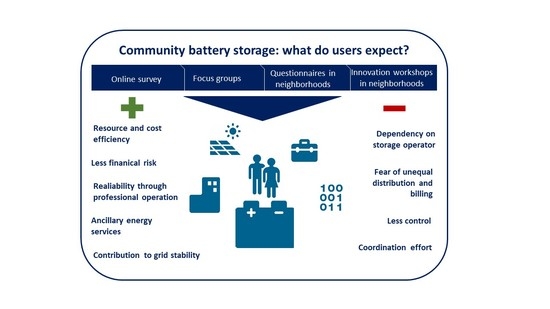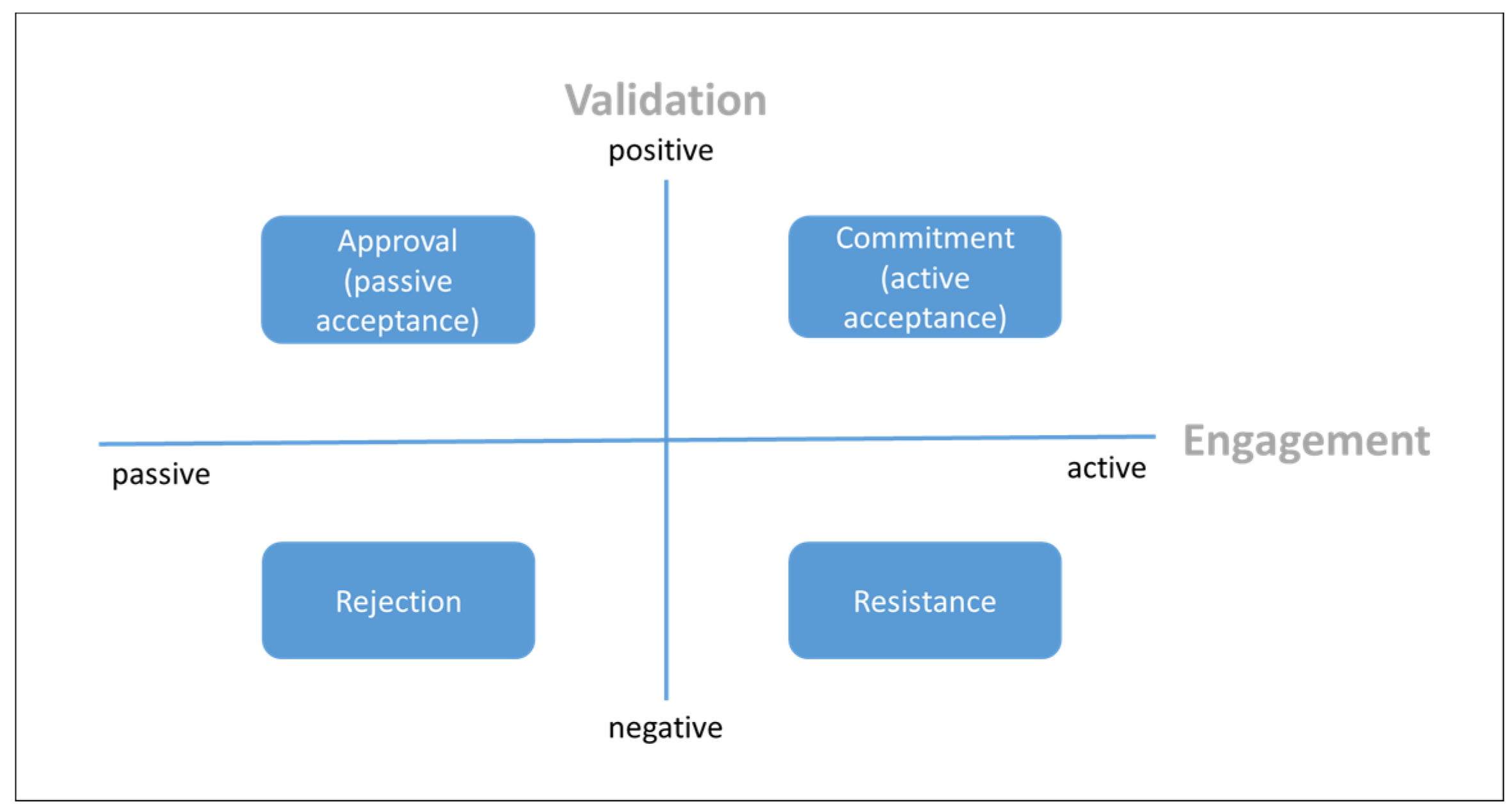Joint Storage: A Mixed-Method Analysis of Consumer Perspectives on Community Energy Storage in Germany
Abstract
1. Introduction
- (1)
- What do PV system users expect from an energy storage system?
- (2)
- What are the conditions under which they would be willing to invest in storage and ancillary services?
- (3)
- Under which conditions would they favor CES over residential storage?
1.1. Dimensions of Technology Acceptance
1.2. Consumer Perceptions Regarding Energy Storage
1.3. Energy Services for CES
2. Materials and Methods
2.1. Neighborhoods
2.2. Research Methods
3. Results—What Do Users Expect from Energy Storage?
3.1. Interest in Energy Storage and Motivation for Investing in Them
“As I said, it depends. As soon as energy storage becomes cheaper, I’ll be able to increase my own [self-] consumption and reduce expenses. But currently such storage systems are simply too expensive.”(Munich 2019—M2, I-105).
“In our street some already had [a storage system], so we started talking about it […], and they named some companies. I did some Internet research […] and then I contacted several companies.”(Hamburg 2019—HH9, I-82).
“The [companies] consulted us and then we decided. […] We bought [from the firm] where the consultation was better and [the assumptions being made] seemed more plausible.”(Hamburg 2019—HH9, I-82).
“Well, there were some surprises. It was not very nice because they simply hadn’t thought it through and we of course didn’t have the necessary knowledge.”(Berlin 2019—B7, I-97).
“Well, it would be nice if someone provided real information and advice instead of only providing a sales quote because I don’t really have a clue.”(Munich 2019—M3, I-108).
3.2. Comparison of Storage Systems and Requirements Concerning Community Storage
“I think community energy storage is a great thing and if there was a system in my district I would participate. My requirement is that it has to be cheaper. The price is the kicker.”(Berlin 2019—B5, III-61).
“With community energy storage I would in effect be safe from failure. When the storage system breaks down […], it’s not my problem.”(Dusseldorf 2018—D3, I-105).
“It’s simply more reliable […] and also better maintained.”(Dusseldorf 2018—D1, I-144).
“If it’s not more expensive I would choose community energy storage because then I don’t have any work with it.”(Munich 2019—M6, III-77).
“[…] Whenever we purchase something that we don’t understand, we either have to acquire knowledge, or we have to find someone who explains it to us and that can be very time-consuming. Therefore, in terms of the required expertise community energy storage would be an advantage for me.”(Berlin 2018—B2, I-62).
“Community energy storage also brings a kind of community spirit: together we are doing something for the environment. Those are the factors that are important to develop acceptance [of the energy transition].”(Dusseldorf 2018—D5, I-219).
“The most important thing would be that there is an equitable distribution. If I constantly feed in [electricity] and others only withdraw, this has to be recorded and compensated in terms of costs.”(Hamburg 2019—HH1, II-21).
“With such a large [storage] system, one again becomes dependent on some kind of operator.”(Munich 2019—M2, II-76).
“Regarding community energy storage, I would be afraid that we all would once again say: ‘Electricity comes from the electrical outlet.’ And this educational effect—of being the master of my own technology and power consumption—would be lost.”(Dusseldorf 2018—D5, I-161).
“Housing companies would be [a possibility], but I wouldn’t really trust them because, sure, they make plans and say: ‘Okay, I need a 15–20 percent return on equity, everything else isn’t of interest to me.’”(Berlin 2018—B7, II-66).
“Municipal utilities that are close by and already have a relationship of trust with the customer, […] I believe they could do it.”(Dusseldorf 2018—D5, II-29).
3.3. Energy Storage Services
“For me, a very important topic is protection against blackouts. […] That is something important and would be great.”(Dusseldorf 2018—D7, III-98).
“I would not like it […] if somebody could tap the electricity from my car because I can never know exactly whether I might have to drive somewhere.”(Berlin 2019—B5, II-55)
“I really see added value in the monitoring service. Someone who professionally operates [an energy storage system] will have a great deal more experience and knowledge than someone who does this on his own.”(Dusseldorf 2018—D1, I-208).
4. Discussion
5. Conclusions
Author Contributions
Funding
Acknowledgments
Conflicts of Interest
References
- Agnew, S.; Dargusch, P. Effect of residential solar and storage on centralized electricity supply systems. Nat. Clim. Chang. 2015, 5. [Google Scholar] [CrossRef]
- Kairies, K.-P.; Magnor, D.; Sauer, D.U. Scientific Measuring and Evaluation Program for Photovoltaic Battery Systems (WMEP PV-Speicher). Energy Procedia 2015, 73, 200–207. [Google Scholar] [CrossRef]
- Wirth, H.; Schneider, K. Aktuelle Fakten zur Photovoltaik in Deutschland; Fraunhofer ISE: Freiburg, Germany, 2020. [Google Scholar]
- Koirala, B.P.; van Oost, E.; van der Windt, H. Community energy storage: A responsible innovation towards a sustainable energy system? Appl. Energy 2018, 231, 570–585. [Google Scholar] [CrossRef]
- Müller, S.C.; Welpe, I.M. Sharing electricity storage at the community level: An empirical analysis of potential business models and barriers. Energy Policy 2018, 118, 492–503. [Google Scholar] [CrossRef]
- van der Schoor, T.; Scholtens, B. Power to the people: Local community initiatives and the transition to sustainable energy. Renew. Sustain. Energy Rev. 2015, 43, 666–675. [Google Scholar] [CrossRef]
- Brummer, V. Community energy—Benefits and barriers: A comparative literature review of community energy in the UK, Germany and the USA, the benefits it provides for society and the barriers it faces. Renew. Sustain. Energy Rev. 2018, 94, 187–196. [Google Scholar] [CrossRef]
- Marczinkowski, H.M.; Østergaard, P.A. Residential versus communal combination of photovoltaic and battery in smart energy systems. Energy 2018, 152, 466–475. [Google Scholar] [CrossRef]
- Koirala, B.P.; Hakvoort, R.A.; van Oost, E.C.; van der Windt, H. Community energy storage: Governance and business models. In Consumer, Prosumer, Prosumager: How Service Innovations Will Disrupt the Utility Business Model; Sioshansi, F., Ed.; Academic Press, an imprint of Elsevier: London, UK, 2019; pp. 209–234. ISBN 978-0-12-816836-3. [Google Scholar]
- Lombardi, P.; Schwabe, F. Sharing economy as a new business model for energy storage systems. Appl. Energy 2017, 188, 485–496. [Google Scholar] [CrossRef]
- van der Stelt, S.; AlSkaif, T.; van Sark, W. Techno-economic analysis of household and community energy storage for residential prosumers with smart appliances. Appl. Energy 2018, 209, 266–276. [Google Scholar] [CrossRef]
- Gährs, S.; Knoefel, J. Anforderungen verschiedener Stakeholder an Dienstleistungen mit Quartierspeichern. Ergebnisse einer Analyse von Stakeholderinterviews. 2018. Available online: https://www.ioew.de/fileadmin/user_upload/BILDER_und_Downloaddateien/Publikationen/2018/G%C3%A4hrs-Knoefel_Anforderungen_verschiedener_Stakeholder_ESQUIRE_2018-09-17.pdf (accessed on 21 April 2020).
- Gährs, S.; Knoefel, J. Stakeholder demands and regulatory framework for community energy storage with a focus on Germany. Energy Policy 2020. accepted. [Google Scholar]
- Ambrosio-Albalá, P.; Upham, P.; Bale, C.S.E. Purely ornamental? Public perceptions of distributed energy storage in the United Kingdom. Energy Res. Soc. Sci. 2019, 48, 139–150. [Google Scholar] [CrossRef]
- Soland, M.; Loosli, S.; Koch, J.; Christ, O. Acceptance among residential electricity consumers regarding scenarios of a transformed energy system in Switzerland—A focus group study. Energy Effic. 2018, 11, 1673–1688. [Google Scholar] [CrossRef]
- Kalkbrenner, B.J. Residential vs. community battery storage systems—Consumer preferences in Germany. Energy Policy 2019, 129, 1355–1363. [Google Scholar] [CrossRef]
- Kloppenburg, S.; Smale, R.; Verkade, N. Technologies of Engagement: How Battery Storage Technologies Shape Householder Participation in Energy Transitions. Energies 2019, 12, 4384. [Google Scholar] [CrossRef]
- Gährs, S.; Hoffmann, E. Dienstleistungen mit Quartierspeichern; e|m|w: Essen, Germany, 2018; pp. 68–70. [Google Scholar]
- Hoffmann, E.; Mohaupt, F.; Ortmanns, M. Akzeptanz von Speicherdienstleistungen und Weiteren Energiedienstleistungen. Stand der Forschung aus Sozialwissenschaftlicher Perspektive. 2018. Available online: https://www.esquire-projekt.de/data/esquire/Datein/Arbeitspapier_Akzeptanz_von_Speicherdienstleistungen_und_weiteren_Energiedienstleistungen.pdf (accessed on 22 April 2020).
- Wolsink, M. The research agenda on social acceptance of distributed generation in smart grids: Renewable as common pool resources. Renew. Sustain. Energy Rev. 2012, 16, 822–835. [Google Scholar] [CrossRef]
- Hoffmann, E. User Integration in Sustainable Product Development: Organisational Learning through Boundary-Spanning Processes; Routledge: Abingdon, UK; New York, NY, USA, 2017; ISBN 978-1-351-27792-1. [Google Scholar]
- Broughel, A.E.; Hampl, N. Community financing of renewable energy projects in Austria and Switzerland: Profiles of potential investors. Energy Policy 2018, 123, 722–736. [Google Scholar] [CrossRef]
- European Commission. EU Reference Scenario 2016: Energy, Transport and GHG Emissions—Trends to 2050. Main Results; European Union: Luxembourg, 2016. [Google Scholar]
- Schäfer, M.; Keppler, D. Modelle der Technikorientierten Akzeptanzforschung. Überblick und Reflexion am Beispiel eines Forschungsprojekts zur Implementierung Innovativer Technischer Energieeffizienz-Maßnahmen; Discussion Paper; Technische Universität Berlin: Berlin, Germany, 2013. [Google Scholar]
- Hildebrand, J.; Rau, I.; Schweizer Ries, P. Akzeptanz und Beteiligung—Ein ungleiches Paar. In Handbuch Energiewende und Partizipation; Holstenkamp, L., Radtke, J., Eds.; Springer VS: Wiesbaden, Germany, 2018; pp. 195–209. [Google Scholar]
- Schweizer-Ries, P.; Rau, I.; Zoellner, J.; Nolting, K.; Rupp, J.; Keppler, D. Aktivität und Teilhabe—Akzeptanz Erneuerbarer Energie durch Beteiligung Steigern; Forschungsgruppe Umweltpsychologie: Magdeburg/Berlin, Germany, 2010. [Google Scholar]
- von Wirth, T.; Gislason, L.; Seidl, R. Distributed energy systems on a neighborhood scale: Reviewing drivers of and barriers to social acceptance. Renew. Sustain. Energy Rev. 2018, 82, 2618–2628. [Google Scholar] [CrossRef]
- Huijts, N.M.A.; Molin, E.J.E.; Steg, L. Psychological factors influencing sustainable energy technology acceptance: A review-based comprehensive framework. Renew. Sustain. Energy Rev. 2012, 16, 525–531. [Google Scholar] [CrossRef]
- Wunderlich, C. Akzeptanz und Bürgerbeteiligung für Erneuerbare Energien. Erkenntnisse aus Akzeptanz-und Partizipationsforschung. Available online: https://www.energiewende-sta.de/wp-content/uploads/2011/09/AEE_Akzeptanz-und-B%c3%bcrgerbeteiligung-EE.pdf (accessed on 22 April 2020).
- Mast, C.; Stehle, H. Energieprojekte im Offentlichen Diskurs: Erwartungen und Themeninteressen der Bevölkerung; 1. Auflage 2016; Springer VS: Wiesbaden, Germany, 2016; ISBN 978-3-658-12710-7. [Google Scholar]
- Jones, C.R.; Gaede, J.; Ganowski, S.; Rowlands, I.H. Understanding lay-public perceptions of energy storage technologies: Results of a questionnaire conducted in the UK. Energy Procedia 2018, 151, 135–143. [Google Scholar] [CrossRef]
- Agnew, S.; Dargusch, P. Consumer preferences for household-level battery energy storage. Renew. Sustain. Energy Rev. 2017, 75, 609–617. [Google Scholar] [CrossRef]
- Gährs, S.; Mehler, K.; Bost, M.; Hirschl, B. Acceptance of ancillary services and willingness to invest in PV-storage-systems. Energy Procedia 2015, 73, 29–36. [Google Scholar] [CrossRef]
- Graebig, M.; Erdmann, G.; Röder, S. Assessment of Residential Battery Systems (RBS): Profitability, Perceived Value Proposition, and Potential Business Models; Technische Universität Berlin: Berlin, Germany, 2014. [Google Scholar]
- Figgener, J.; Haberschusz, D.; Kairies, K.-P.; Wessels, O.; Tepe, B.; Sauer, D.U. Wissenschaftliches Mess- und Evaluierungsprogramm Solarstromspeicher 2.0; Annual Report; RWTH Aachen: Aachen, Germany, 2018. [Google Scholar]
- Smale, H.; Rowlands, I.H.; Gaede, J. A Gap Analysis. Community Acceptance of Energy Storage Projects; University of Waterloo: Waterloo, Canada, 2017. [Google Scholar]
- Wawer, T.; Griese, K.-M.; Halstrup, D.; Ortmann, M. Stromspeicher im Quartier: Aktuelle Herausforderungen und Geschäftsmodelle in Deutschland. Z. Für Energiewirtschaft 2018, 42, 225–234. [Google Scholar] [CrossRef]
- MVV Energie AG; Universität Stuttgart; Netrion; ADS-TEC. Strombank—Innovatives Betreibermodell für Quartierspeicher. 2016. Available online: http://fachdokumente.lubw.baden-wuerttemberg.de/servlet/is/120150/bwe13017_13020.pdf?command=downloadContent&filename=bwe13017_13020.pdf&FIS=203 (accessed on 22 April 2020).
- Graulich, K.; Hilbert, I.; Heinemann, C. Einsatz und Wirtschaftlichkeit von Photovoltaik-Batteriespeichern in Kombination mit Stromsparen. Kurzinformation für Verbraucherinnen und Verbraucher; Öko-Institut e.V.: Freiburg, Germany, 2018. [Google Scholar]
- Geelen, D.; Reinders, A.; Keyson, D. Empowering the end-user in smart grids: Recommendations for the design of products and services. Energy Policy 2013, 61, 151–161. [Google Scholar] [CrossRef]
- Schnabel, F.; Kreidel, K. Dienstleistungen für Gemeinschaftlich Genutzte Quartierspeicher; Fraunhofer-Institut für Arbeitswirtschaft und Organisation IAO: Stuttgart, Germany, 2019. [Google Scholar]
- Parra, D.; Swierczynski, M.; Stroe, D.I.; Norman, S.A.; Abdon, A.; Worlitschek, J.; O’Doherty, T.; Rodrigues, L.; Gillott, M.; Zhang, X.; et al. An interdisciplinary review of energy storage for communities: Challenges and perspectives. Renew. Sustain. Energy Rev. 2017, 79, 730–749. [Google Scholar] [CrossRef]
- ENTEGA. Besser Wachsen. Geschäftsbericht 2018; ENTEGA: Darmstadt, Germany, 2018. [Google Scholar]
- ENTEGA. Besser Handeln. Nachhaltigkeitsbericht 2018; ENTEGA: Darmstadt, Germany, 2018. [Google Scholar]
- Statista. Länge der Versorgungsunterbrechung je Stromverbraucher in Deutschland in den Jahren 2006 bis 2018; Statista GmbH: Hamburg, Germany, 2019. [Google Scholar]
- Gährs, S.; Knoefel, J.; Cremer, N. Politische Zielsetzungen und Rechtlicher Rahmen für Quartierspeicher—Bestandsaufnahme der Aktuellen Rahmenbedingungen und Diskurse. 2018. Available online: https://www.esquire-projekt.de/data/esquire/Datein/Arbeitspapier_Politische_Zielsetzungen_und_rechtlicher_Rahmen_fuer_Quartierspeicher-aktualisiert.pdf (accessed on 25 March 2020).
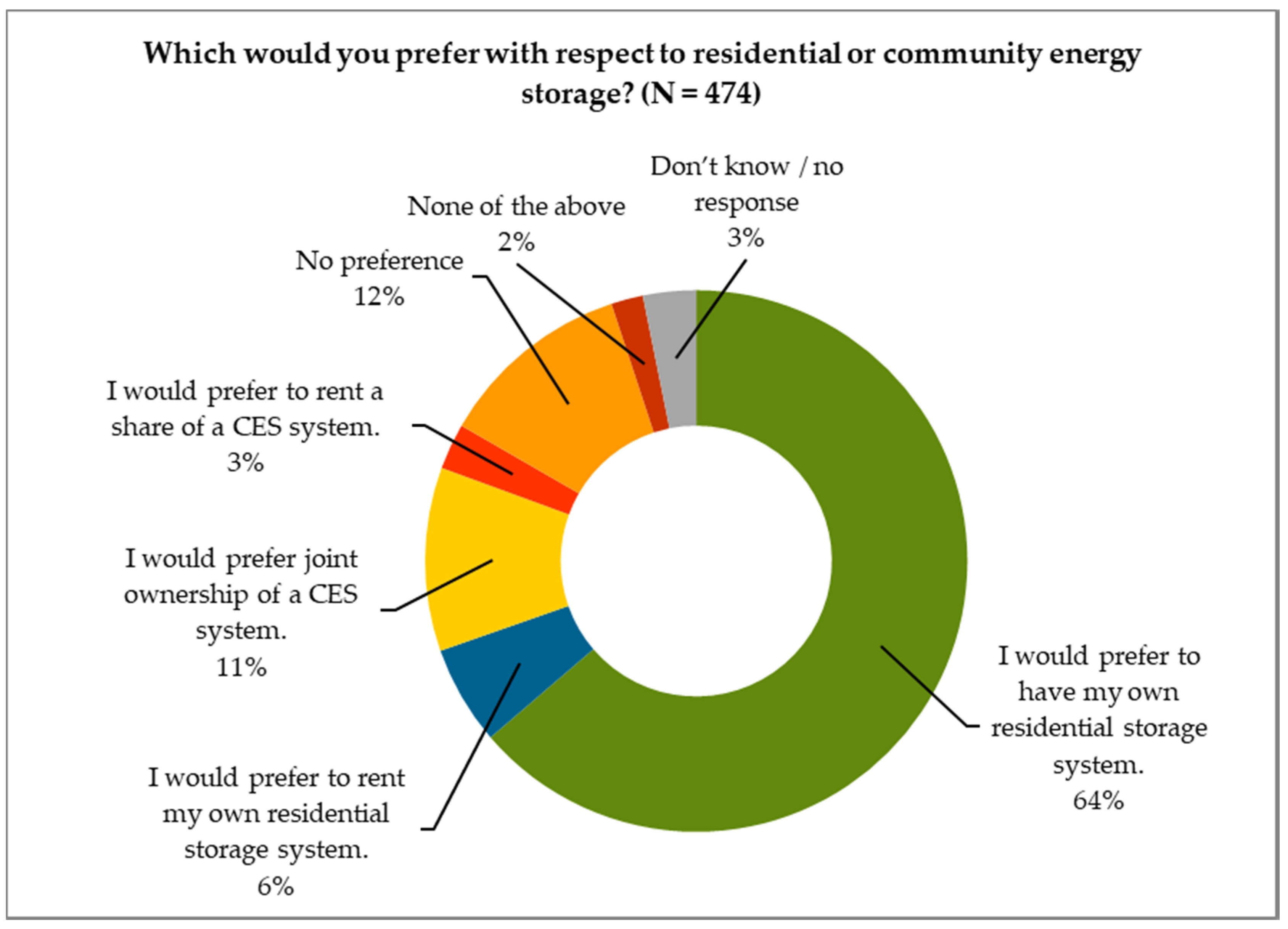
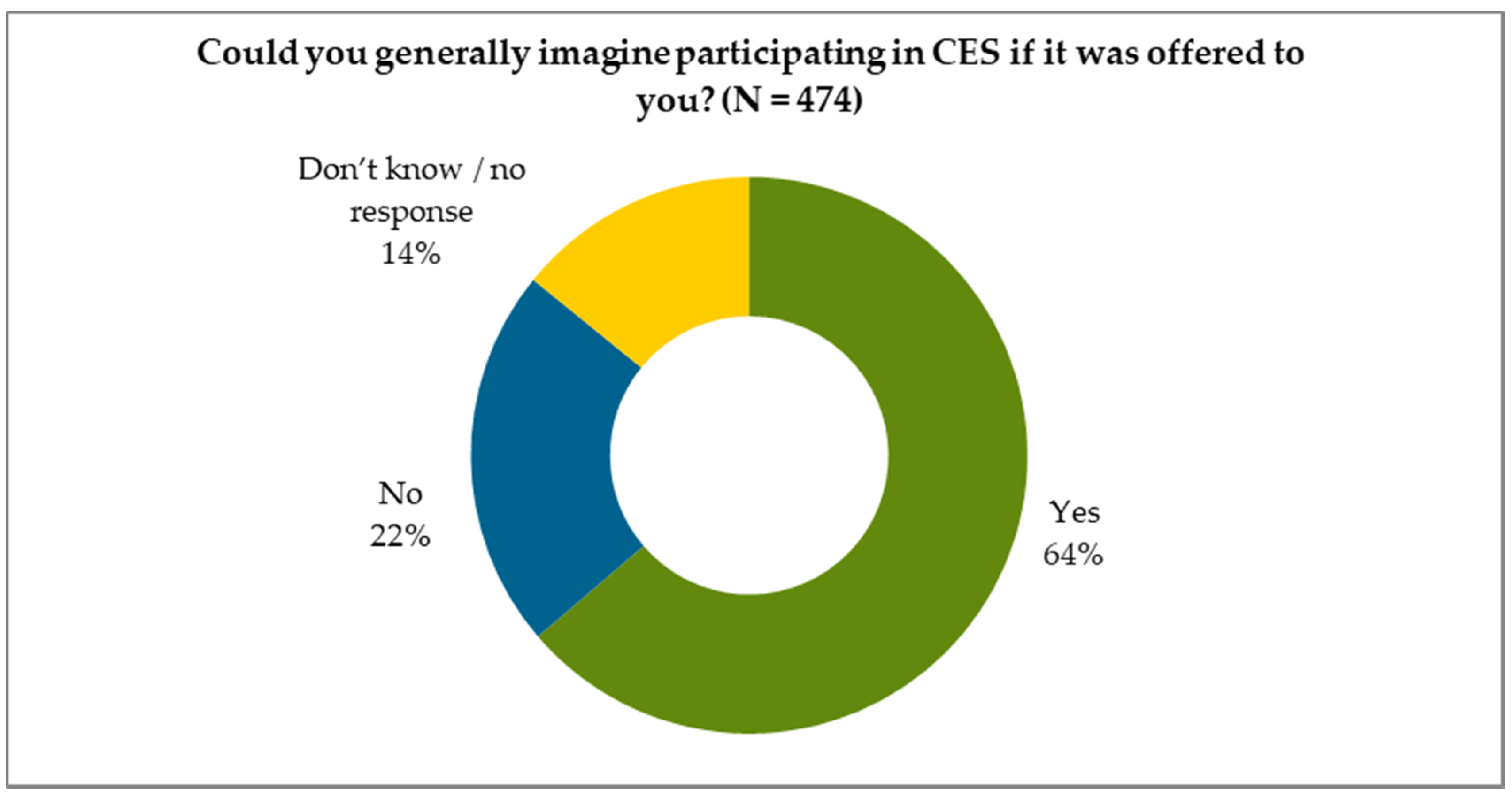
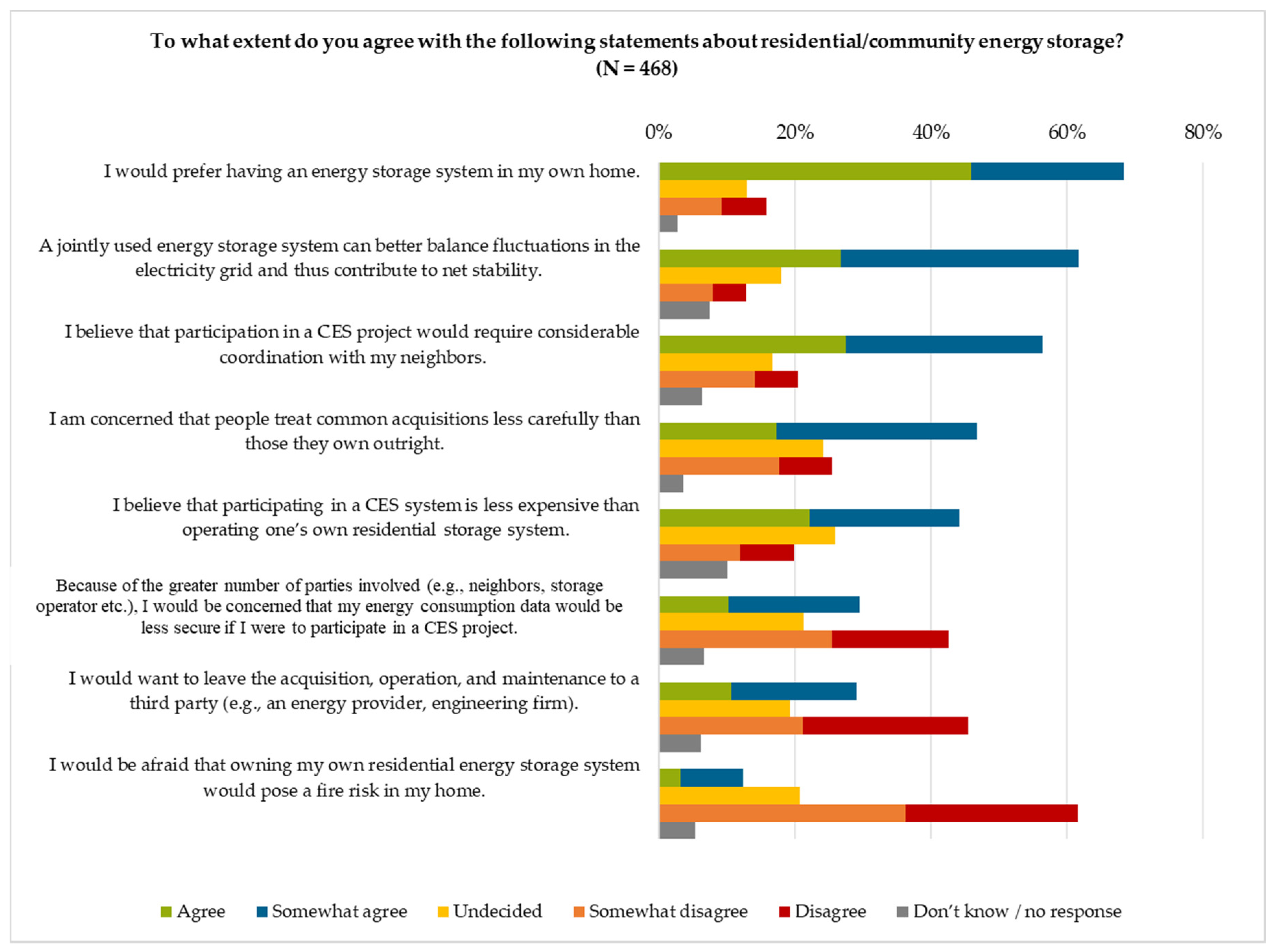
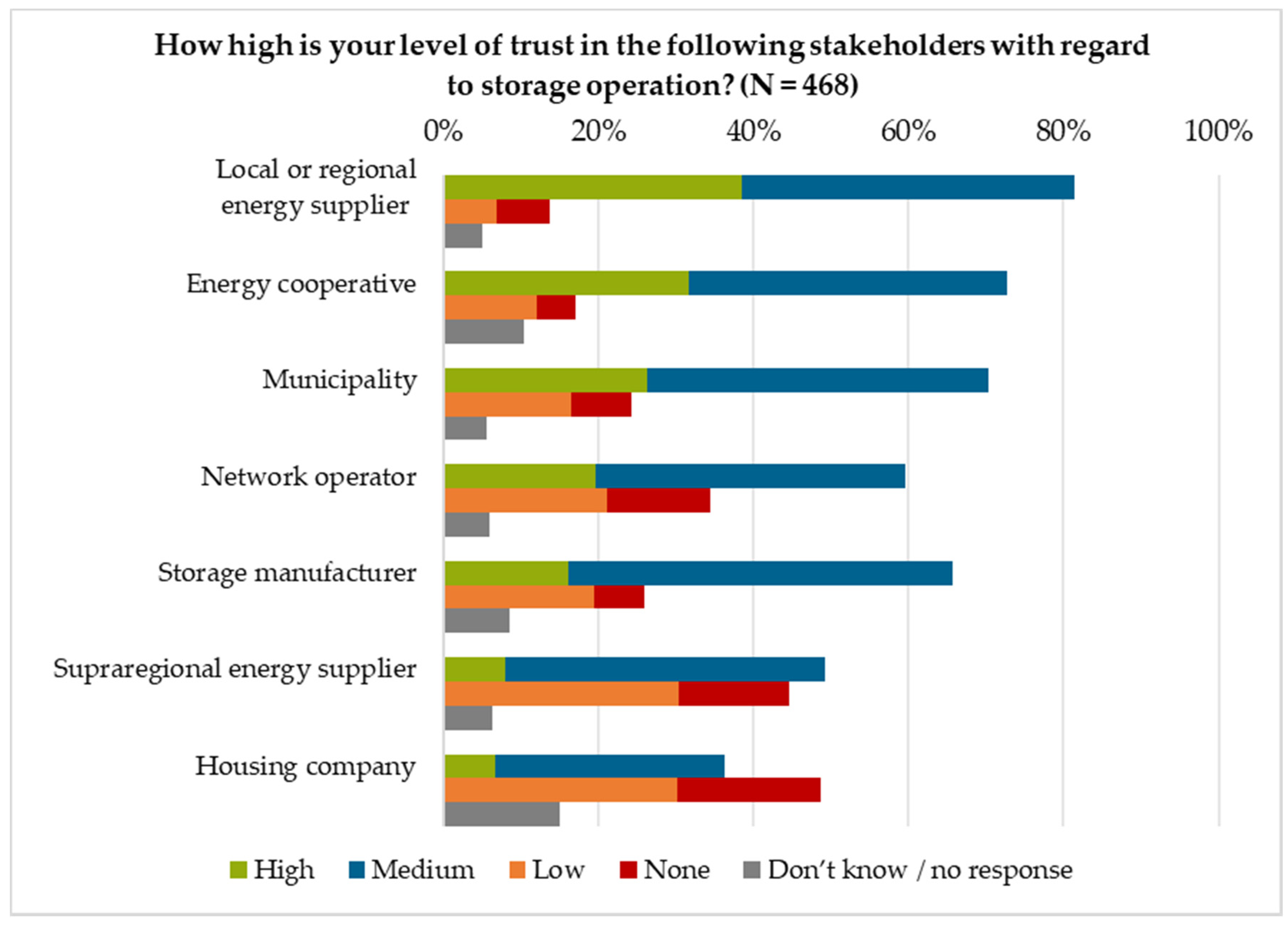

| Method | Attribute | Characteristics |
|---|---|---|
| Online survey | Number of participants | N = 474 |
| Gender | 91% male, 6% female, 3% not stated | |
| Experience with PV and energy storage | 95% PV system owners;25% rely on or have access to an energy storage system | |
| Living situation | 98% homeowners (about two-thirds single-family dwellings, one-fifth two-family, and a small share of apartments); 1% tenants | |
| Focus groups | Number of participants | 2018: Berlin, N = 9; Dusseldorf, N = 7; 2019: Berlin, N = 8; Hamburg, N = 12; Munich N = 9 |
| Gender | 2018: Berlin, 6 male, 3 female; Dusseldorf, 7 male, 0 female; 2019: Berlin, 5 male, 3 female; Hamburg, 7 male, 5 female; Munich, 7 male, 2 female | |
| Experience with PV and energy storage | All participants were PV system owners; some were also storage users: 2018: Berlin: 3; Dusseldorf: 1; 2019: Berlin: 5; Hamburg: 9; Munich: 7; in Munich and Hamburg some were joint owners of a storage system together with others in their house (Hamburg 2019: 7; Munich 2019: 3). | |
| Living situation | Homeowners (house or apartment) | |
| Questionnaires (neighborhoods) | Number of participants | Groß-Umstadt: N = 18, Cologne: N = 35 |
| Gender | Groß-Umstadt: 11 male, 5 female, 2 not stated Cologne: not collected | |
| Experience with PV and energy storage | Groß-Umstadt: PV system owners; CES users (N = 11) Cologne: users of community energy system including CES | |
| Living situation | Homeowners (Groß-Umstadt: house, Cologne: apartment) | |
| User innovation workshops (neighborhoods) | Number of participants | Groß-Umstadt: N = 20 (from 14 households), Cologne: N = 15 |
| Gender | Groß-Umstadt: 14 male, 6 female, Cologne: 8 male, 7 female | |
| Experience with PV and energy storage | Groß-Umstadt: PV system owners, CES users Cologne: users of community energy system including CES | |
| Living situation | Owners (Groß-Umstadt: house, Cologne: apartments) |
| Motive | Respondents without Storage System (N = 276) | Respondents with Storage System (N = 111) | ||
|---|---|---|---|---|
| Average Rank | Position | Average Rank | Position | |
| I can increase self-consumption of renewable energy. | 5.802 | 1 | 6.275 | 1 |
| I contribute to climate protection. | 4.243 | 2 | 4.091 | 3 |
| I want to become more independent from the electricity supplier. | 4.234 | 3 | 4.149 | 2 |
| I can reduce the burden of rising energy prices. | 3.901 | 4 | 3.268 | 5 |
| I increase the use of renewable energies. | 3.856 | 5 | 3.975 | 4 |
| I use an innovative product | 2.243 | 6 | 1.663 | 6 |
| The storage system increases my property value. | 1.613 | 7 | 1.496 | 7 |
| Other | 0.306 | 8 | 0.417 | 8 |
| Conditions | Average Rank | Position |
|---|---|---|
| Rental fee for CES should be less than the reduction in electricity cost attained using the CES system. | 5.777 | 1 |
| Users can freely choose their electricity provider. | 3.452 | 2 |
| Storage operator should ensure higher proportion or renewable energies in the neighborhood. | 3.130 | 3 |
| Storage operator should use the storage system for grid relief. | 2.729 | 4 |
| The storage is offered in combination with energy consulting. | 2.277 | 5 |
| The storage contract could be cancelled upon short notice. | 1.967 | 6 |
| Other | 0.497 | 7 |
© 2020 by the authors. Licensee MDPI, Basel, Switzerland. This article is an open access article distributed under the terms and conditions of the Creative Commons Attribution (CC BY) license (http://creativecommons.org/licenses/by/4.0/).
Share and Cite
Hoffmann, E.; Mohaupt, F. Joint Storage: A Mixed-Method Analysis of Consumer Perspectives on Community Energy Storage in Germany. Energies 2020, 13, 3025. https://doi.org/10.3390/en13113025
Hoffmann E, Mohaupt F. Joint Storage: A Mixed-Method Analysis of Consumer Perspectives on Community Energy Storage in Germany. Energies. 2020; 13(11):3025. https://doi.org/10.3390/en13113025
Chicago/Turabian StyleHoffmann, Esther, and Franziska Mohaupt. 2020. "Joint Storage: A Mixed-Method Analysis of Consumer Perspectives on Community Energy Storage in Germany" Energies 13, no. 11: 3025. https://doi.org/10.3390/en13113025
APA StyleHoffmann, E., & Mohaupt, F. (2020). Joint Storage: A Mixed-Method Analysis of Consumer Perspectives on Community Energy Storage in Germany. Energies, 13(11), 3025. https://doi.org/10.3390/en13113025



